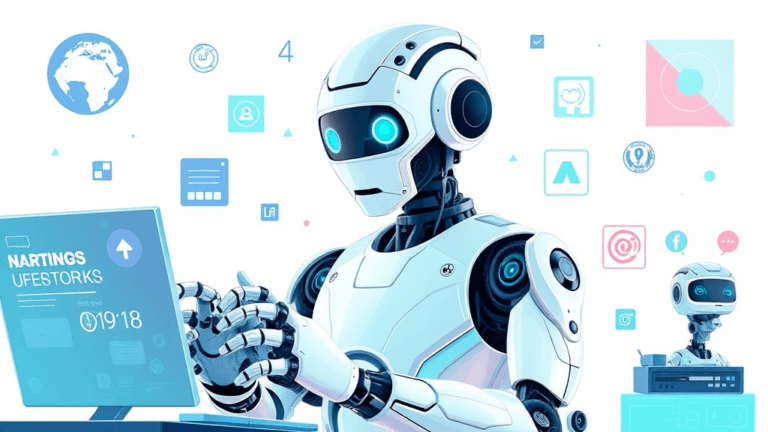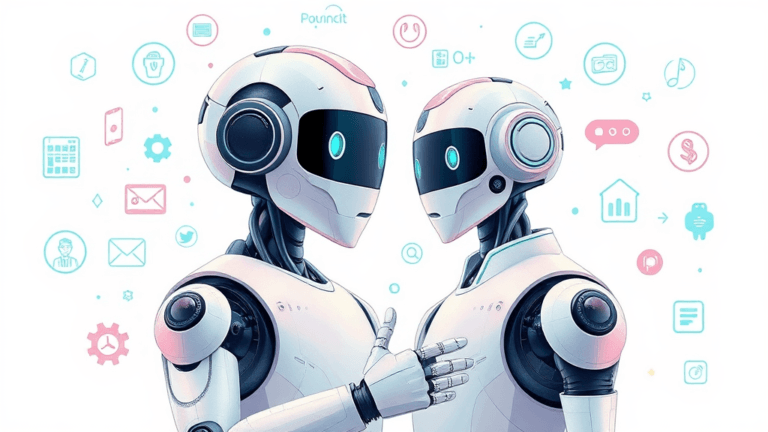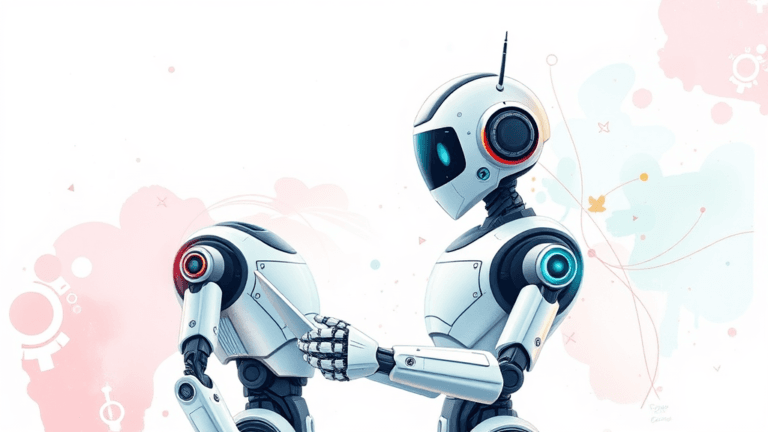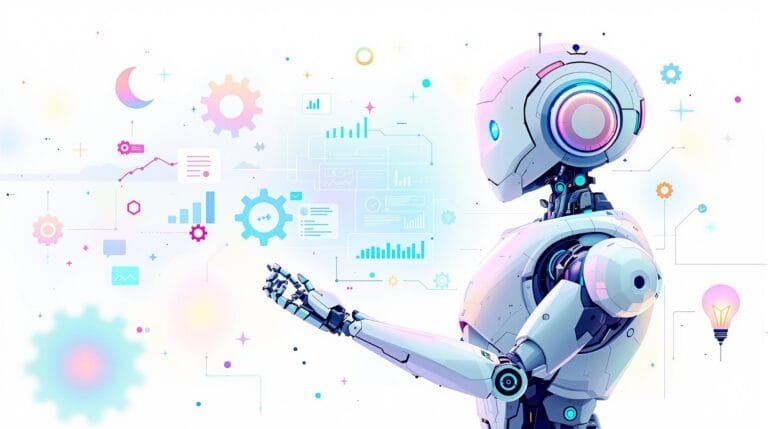
AI Automation Services: The Game-Changer Your Business Needs
Estimated reading time: 12 minutes
Table of Contents
- What Are AI Automation Services?
- Benefits of AI Automation for Business
- Customized AI Solutions: One Size Fits None
- AI-Powered Business Solutions for Every Department
- Seamless Integration: Making AI Play Nice with Your Current Systems
- The Unfair Advantage: Why AI Adopters Leaves Competitors in the Dust
- Picking Your AI Sidekick: Features That Matter
- The AI Buyer’s Checklist: Don’t Get Sold a Lemon
- From Blueprint to Reality: Your AI Implementation Roadmap
- Dodging AI Implementation Landmines
- Measuring AI’s Magic: Beyond the Hype Metrics
- Keeping Your AI Sharp: The Maintenance Mindset
- Conclusion: Your AI Future Starts Now
Imagine this: Your competitor just slashed their customer service response time by 60%, doubled their sales leads, and reduced operational costs—all while you’re stuck manually processing invoices. What’s their secret? AI automation services. (AI Automation For Business Success) These intelligent systems aren’t just futuristic buzzwords; they’re reshaping industries faster than you can say “machine learning.” Let’s dive into how AI-driven solutions are flipping the script on traditional business operations—and why your company can’t afford to ignore them.
According to recent studies, businesses using AI automation report up to 40% boosts in productivity. (How AI Can Save Your Business Time And Money Through Automation) It’s not just about replacing spreadsheets with algorithms—it’s about unlocking a new level of efficiency, creativity, and customer satisfaction. Ready to learn how this technology could rewrite your business playbook? Let’s break it down.
What Are AI Automation Services?
AI automation services are like hiring a team of supercharged, tireless employees who work 24/7 without coffee breaks. At their core, they combine artificial intelligence (AI) technologies—machine learning, natural language processing, and robotic process automation—to handle tasks that typically require human brainpower. Think of them as your business’s autopilot mode for everything from sorting customer emails to predicting next quarter’s sales trends.
How Is This Different from “Regular” Automation?
Old-school automation is like a train: It follows fixed tracks (rules) and stops dead if something blocks the path. AI-powered business solutions, however, are more like self-driving cars—they adapt to roadblocks, learn from past trips, and even suggest better routes. (How Can AI Help Business)
| Feature | Traditional Automation | AI Automation |
|---|---|---|
| Decision-Making | Follows preset rules | Learns and adapts dynamically |
| Handling Unusual Scenarios | Fails or requires manual intervention | Innovates solutions autonomously |
| Improvement Over Time | Static unless reprogrammed | Evolves with new data and patterns |
For example, a rule-based system might flag every $1,000+ transaction as suspicious. An AI system? It’ll analyze hundreds of factors (purchase history, location, timing) to spot real fraud risks—no awkward “Your Legit Purchase Is Blocked” emails. Salesforce research shows companies using adaptive AI systems reduce false positives by up to 70%.
Benefits of AI Automation for Business
Why are CEOs from Tokyo to Tulsa obsessed with AI automation for business? Because it’s not just about cutting costs—it’s about amplifying every aspect of operations.
1. Efficiency That Would Make a Swiss Watch Jealous
Full AI automation (How AI Can Save Your Business Time And Money Through Automation) eliminates bottlenecks faster than you can say “manual data entry.” Case in point: A retail chain automated its inventory management and reduced stockouts by 55% while trimming excess inventory costs by 30% (Moveworks).
2. Decisions Smarter Than a Roomful of Experts
AI-powered business solutions (How Can AI Help Business) analyze data at scales humans can’t match. Imagine your marketing team accessing insights from 10,000 customer surveys in seconds—not weeks.
3. Scaling Without the Headaches
Growing from 100 to 10,000 daily orders? With AI automation for business, scaling IT infrastructure or customer support happens seamlessly—no hiring sprees required.
4. Fewer “Oops” Moments
Humans make ~3 errors per 100 data entries. AI? Try 0.5—and those usually get caught by self-correcting algorithms.
5. Always-On Availability
While your team sleeps, AI handles midnight customer queries, monitors systems, and even negotiates with suppliers in different time zones.
6. Customers Who Feel Like VIPs
A bank using AI chatbots saw 90% of routine inquiries resolved instantly, freeing agents to tackle complex issues. (AI Customer Service Agent Revolution) Happy customers = 35% higher retention rates.
Customized AI Solutions: One Size Fits None
Here’s the hard truth: Off-the-shelf AI tools are like bargain-bin suits—they technically cover you but miss the mark on fit. Customized AI solutions (Preparing Business Wide Scale AI 2) are tailor-made ecosystems designed around your workflows, challenges, and goals.
Why Generic Tools Fall Short
- Can’t integrate with legacy systems (looking at you, 1998 payroll software)
- Lack industry-specific smarts (healthcare compliance vs. e-commerce trends)
- Force you to change processes to fit the tool—not the other way around
A pharmacy chain learned this the hard way. Their generic inventory AI kept ordering snow shovels in Miami. A tailored automation system fixed it by incorporating local weather data and prescription patterns (ABBYY).
Building Your AI Dream Team
A well-designed tailored automation system should:
- Plug-and-Play with existing tools (no IT nightmares)
- Speak Your Industry’s Language—HIPAA compliance for healthcare, real-time tariffs for logistics
- Grow With You—handle 10x more data or users without costly upgrades
- Keep Humans in the Loop—flagging decisions needing a manager’s eye
AI-Powered Business Solutions for Every Department
From HR to shipping docks, AI-powered business solutions are turning routine tasks into strategic opportunities.
| Department | AI Tools | Impact |
|---|---|---|
| Customer Service | Chatbots, sentiment analysis | 24/7 support, 50% faster resolutions |
| Sales & Marketing | Lead scoring, dynamic pricing engines | 20% higher conversion rates |
| Human Resources | Resume screening, engagement predictors | 30% faster hiring, lower turnover |
| Finance | Fraud detection, cash flow forecasting | 60% fewer false alarms |
| Supply Chain | Demand forecasting, route optimization | 25% lower logistics costs |
| Manufacturing | Predictive maintenance, defect detection | 40% fewer machine breakdowns |
Real-World Magic
- A beverage company’s AI predicts flavor trends 6 months early, guiding R&D.
- An insurer uses image recognition to process claims in 8 minutes (vs. 3 days).
The kicker? These systems learn as they go. A retail AI initially confused spatulas and paint stirrers—but after analyzing 10,000 images, it now nails 99.9% of product categorizations.
Next Steps: In part two of this guide, we’ll explore how to choose the right AI tools, dodge implementation pitfalls, and measure your ROI. Spoiler: It involves more than just counting saved hours.
Note: This is part one of a two-part series. Stay tuned for actionable steps to launch your AI transformation.
Seamless Integration: Making AI Play Nice with Your Current Systems
Ever tried to fit a square peg in a round hole? That’s what implementing new tech often feels like for businesses—unless you’re using AI-powered business solutions designed for seamless integration. These systems don’t just bulldoze your existing workflows; they enhance them like a GPS for your operations.
The Invisible Bridge: How AI Connects to Your Tech Stack
Modern AI automation services use three key approaches to merge with your processes:
- APIs: Like digital handshakes between software, letting your CRM chat with AI prediction models
- Cloud Platforms: Central hubs where your data and AI tools collaborate in real time
- Custom Middleware: Tailored connectors for legacy systems (yes, even that ancient inventory database)
A Midwest manufacturer upgraded their 20-year-old ERP system with AI using custom APIs. Result? Production delays dropped by 40% without replacing their core software (ABBYY).
| Integration Method | Best For | Implementation Time |
|---|---|---|
| Pre-built APIs | Cloud-based ecosystems | 2-4 weeks |
| Custom Connectors | Legacy systems | 8-12 weeks |
| Low-code Platforms | Rapid prototyping | 1-3 weeks |
The Unfair Advantage: Why AI Adopters Leaves Competitors in the Dust
Here’s a not-so-secret secret: Companies using AI technology for businesses grow revenue 2-3x faster than their analog competitors. How? By turning data into decisions faster than you can say “market shift.”
Three Ways AI Redefines Competition
- Operational Ninja Moves
AI spots inefficiencies humans miss—like that warehouse routing pattern wasting 200 hours monthly. - Crystal Ball Decision-Making
Predictive analytics forecast demand surges before your suppliers even check their calendars. - Customer Whisperer Skills
Natural language processing detects frustration in support tickets, triggering instant escalations.
A European retailer used AI-powered trend analysis to spot a viral TikTok product trend 11 days before competitors. They dominated holiday sales while others scrambled to restock (Salesforce).
Picking Your AI Sidekick: Features That Matter
Choosing automation software is like dating—settle for flashy looks over substance, and you’ll regret it by month two.
Non-Negotiable Features in AI Tools
- Shape-Shifting Scalability
Can it handle 10x your current transaction volume without breaking a sweat? - Polyglot Compatibility
Fluent in your existing tech stack’s “language” (SAP, QuickBooks, etc.) - Guardian-Level Security
GDPR? HIPAA? PCI-DSS? Your AI should know compliance like a constitutional lawyer - Transparent Brainpower
No black boxes—you need to see how decisions are made for audits
| Provider | Standout Feature | Ideal For |
|---|---|---|
| IBM Watson | Industry-specific healthcare tools | Complex regulatory environments |
| Google Cloud AI | Best-in-class NLP | Global customer interactions |
| Microsoft Azure AI | Seamless Office 365 integration | Enterprises using Microsoft ecosystems |
| AWS AI | Ultra-scalable ML models | High-growth startups |
The AI Buyer’s Checklist: Don’t Get Sold a Lemon
Evaluating AI automation for business options? Avoid shiny object syndrome with this reality check:
5 Questions to Gut-Check Vendors
- “Show me three clients in our industry with measurable ROI”
- “How does your model handle [our specific edge case]?”
- “Walk me through your disaster recovery plan”
- “What’s included in year 2 support costs?”
- “Can we tour your cybersecurity certifications?”
Fun fact: 68% of failed AI implementations trace back to mismatched use cases, not tech flaws. Do your homework!
From Blueprint to Reality: Your AI Implementation Roadmap
Deploying full AI automation isn’t a “set and forget” microwave dinner—it’s a seven-course meal requiring careful prep.
The 9-Step Success Recipe
- Process Autopsy
Map every workflow—even Karen’s “special” spreadsheet for client onboarding - Goal Setting
Aim for “Reduce shipping errors by 35% in 6 months,” not vague “improve efficiency” - Vendor Trials
Test-drive tools with your actual data, not their prepped demo - Phased Rollout
Start with non-critical processes (AP automation before customer-facing chatbots) - Data Spring Cleaning
Fix duplicate entries, missing fields, and that 2018 sales data haunting your CRM - Staff Bootcamp
Train teams on why AI helps them, not just how to click buttons - Go-Live with Training Wheels
Run AI and legacy systems parallel for a month - Feedback Frenzy
Gather input from frontline users weekly - Optimize Like a Pro
Use AI’s own analytics to tweak models continuously
Dodging AI Implementation Landmines
Even Silicon Valley giants stumble with AI. Here’s how to avoid faceplants:
Common Pitfalls (and Lifelines)
- “Our Data’s Fine!” Denial
💡 Fix: Run a data audit before writing your first check - Departmental Mutiny
💡 Fix: Involve teams in tool selection—host “AI Petting Zoo” demo days - Integration Hangover
💡 Fix: Demand vendor-provided integration specialists
A logistics company avoided a $2M mistake by testing their shipment routing AI with historical hurricane season data. Moral? Stress-test for edge cases!
Measuring AI’s Magic: Beyond the Hype Metrics
Track these AI-powered business solutions metrics religiously:
The ROI Trifecta
- Time Resurrection
Hours saved monthly (convert to $$$ at employee hourly rates) - Error Eradication
Reduced rework costs and customer compensation - Growth Geometry
New capabilities unlocked (24/7 service, hyper-personalization)
A B2B SaaS firm discovered their AI chat tool didn’t just cut support costs—it uncovered 12% of feature requests guiding their roadmap. Sometimes the best ROI is unexpected!
Keeping Your AI Sharp: The Maintenance Mindset
Customized AI solutions aren’t fire-and-forget missiles. They’re more like championship athletes needing constant coaching.
The Optimization Playbook
- Monthly: Check model drift (is accuracy slipping?)
- Quarterly: Explore new data sources (IoT sensors? Partner APIs?)
- Biannually: Pressure-test with worst-case scenarios
- Annually: Review vendor landscape for breakthrough tools
Pro Tip: Create an “AI Council” mixing IT, ops, and frontline staff to spot optimization gold.
Conclusion: Your AI Future Starts Now
Let’s get real—the question isn’t “Can we afford AI?” but “Can we afford not to?” From slashing operational fat to predicting market tsunamis, AI automation services are the ultimate business multipliers.
The kicker? Early adopters aren’t just gaining ground—they’re redrawing industry maps. That boutique marketing agency using AI content tools? They’re taking enterprise clients from dinosaurs still “brainstorming” campaigns manually.
PureAISolution.com doesn’t just sell tech—we build your AI compass for uncharted markets. From first-step consultations to full-scale transformations, we’re your copilots in the intelligent automation revolution.
Key Takeaways
- AI integration works best when enhancing existing systems, not replacing them
- Custom solutions outperform generic tools by addressing unique business DNA
- Vendor selection requires scrutinizing industry expertise and hidden costs
- Successful implementation hinges on staff buy-in and phased rollouts
- Continuous optimization turns good AI into unbeatable competitive moats
- ROI extends beyond cost savings to innovation and market agility
FAQs
1. How long until we see ROI from AI automation?
Most businesses notice efficiency gains in 3-6 months, with full ROI typically within 12-18 months.
2. Can small businesses afford AI solutions?
Absolutely! Scalable pricing models and cloud-based tools make AI accessible without massive upfront costs.
3. What’s the biggest implementation mistake to avoid?
Neglecting data quality—garbage in, garbage out applies doubly to AI.
4. How do we handle employee resistance?
Involve teams early, emphasize AI as a workload reducer (not job replacer), and provide hands-on training.
5. Are AI decisions legally defensible?
With proper documentation and human oversight layers, yes—critical for regulated industries.
6. Can AI handle industry-specific jargon/processes?
Custom NLP models can be trained on your technical documents and communication logs.
7. How often do AI models need updating?
Plan for quarterly tweaks and major retraining every 12-18 months as business needs evolve.
8. What if our needs change post-implementation?
Flexible platforms allow adding new modules (e.g., switching from basic chatbots to sentiment-aware interfaces).
9. How secure is sensitive data with AI systems?
Reputable providers offer encrypted data handling and compliance certifications—always verify!
10. Where should we start if completely new to AI?
Begin with a single high-impact process like document processing or customer inquiry routing.






